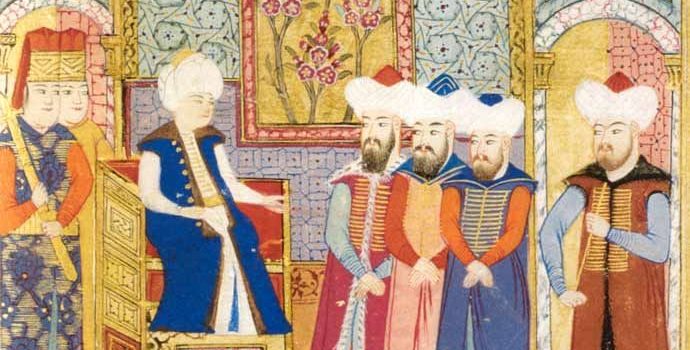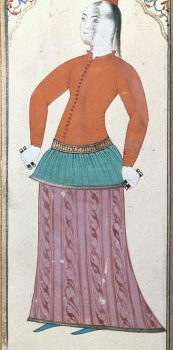This is a collection of seam finishes from 16th- and early 17th-century undergarments in the Topkapi Palace collection, as documented by Raziye Çelik in her thesis Topkapı Sarayı Müzesi’ndeki iç giyim örneklerinin incelenmesi üzerine bir araştırma (2013). (Link coming when I can find a copy that’s not via Docplayer.) I…
Continue reading
A friend in a SCAdian Janissary band invited me to look over his group’s uniforms and help him make them more historically accurate. (He’s excited about my research now. Wait until I tell him everyone has to wear wool coats and two pairs of wool pants. In Pennsylvania. In August.)…
Continue reading
The Türkisches Kostümbuch, painted in 1574 by Lambert de Vos, is an oft-copied album of watercolors done while de Vos was in Istanbul. Several of the figures wear orange or a strong pink. One picture shows a man in a pink kaftan dining with men who wear true red clothes,…
Continue reading
Late 16th Century Color Words These words appeared in Istanbul-area estate records from the late 16th and early 17th centuries. Erguvânî or erguvan, literally “Judas-flower.” Suraiya Faroqhi describes the color as “a blue-tinged red” [link]; I would call it hot pink, fuchsia, or magenta. In modern Turkish, the word refers to a…
Continue reading
Everybody knows there are no pink or orange 16th-century garments in the Topkapi Palace collections. Right? I certainly thought so, and I’ve spent a couple years on this. Some friends set me right. A note: Photos of the Topkapi collection range from the pornographically detailed to the godawful. A few…
Continue reading

[Here’s a puzzle for you: There are no pink or orange 16th-century garments in the Topkapi collections, but the art of the period is full of them. Is it just a painters’ convention, a way to break up the endless ranks of people dressed in fashionable red? Maybe. But why…
Continue reading
Using paintings to determine what colors people wore is tempting, but it has one major flaw: Dyes and painting pigments don’t match. If an artist couldn’t depict a color, he wasn’t going to show people wearing it, no matter how common it was. Conversely, if a particular paint was costly,…
Continue reading
In the fifth month of 1594-1595, the religious scholar Abdürrahim b. Pîrî complained that Kalender Çavuş b. Hasan had stolen some of his goods. The court case gives a listing of his stolen goods: bir sepet ile bir garâr içinde laciverd dolamalık çuka ve bir laciverd çuka ferâce ve bir alaca peşkir ve on…
Continue reading

Museum collections around the world can show you, in exquisite detail, how the richest of the richest Ottoman Turks decorated their clothes. What about the middle and working classes? Pattern-woven and printed cottons were mainstays of the textile trade, but only a tiny handful made it into museum collections, and…
Continue reading
These descriptions come from the kadisicilleri.org court files labeled Üsküdar 05. At this early date, many of the slaves are unnamed, and their descriptions are in Arabic rather than in the Ottoman Turkish of later records. Because of the difficulty of translating Arabic, I’ve omitted descriptions of the slaves. The bolded…
Continue reading





